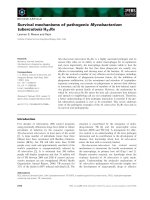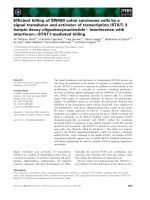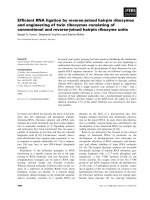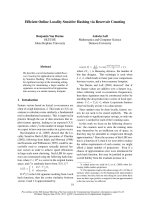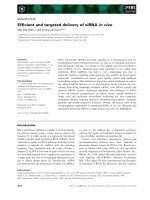Báo cáo khoa học: Insufficient hydrogen-bond desolvation and prion-related disease ppt
Bạn đang xem bản rút gọn của tài liệu. Xem và tải ngay bản đầy đủ của tài liệu tại đây (363.44 KB, 4 trang )
PRIORITY PAPER
Insufficient hydrogen-bond desolvation and prion-related disease
Ariel Ferna
´
ndez*
Institute for Biophysical Dynamics, The University of Chicago, Chicago, IL, USA
A structuring and eventual exclusion of water surrounding
backbone hydrogen bonds takes place during protein fold-
ing as hydrophobic residues cluster around such bonds.
Taken as an average over all hydrogen bonds, the extent of
desolvation is nearly a constant of motion, as revealed by
re-examination of the longest all-atom trajectory with
explicit solvent [Y. Duan & P. A. Kollman (1998) Science
282, 740]. Furthermore, this extent of desolvation is pre-
served across native soluble proteins, except for cellular
prion proteins. Thus, a physico-chemical picture of prion-
related disease emerges. The epitope for protein-X binding,
the region undergoing vast conformational change and the
trigger and locker for this change are inferred from the
location of under-desolvated hydrogen bonds in the cellular
prion protein.
Keywords: protein folding; hydrogen bond; backbone
desolvation; all-atom trajectory; prions.
The progressive structuring, immobilization and ultimate
removal of water surrounding the backbone hydrogen
bonds (HBs) of a protein turn the latter into major
determinants of protein folding and structure [1–5].
However, to the best of my knowledge, a systematic
examination of evolving environments surrounding back-
bone HBs has been lacking. The inherent stability of
such bonds is essentially defined by the solvation free
energy of the unbound reference state with its exposed
backbone polar groups, the amides and carbonyls [1–3].
Thus, most of HB stability is brought about by the
destabilization of the unbound state due to progressive
removal of surrounding water from the backbone polar
moieties.
The inaccessibility of HBs to solvent takes place as the
protein places hydrophobes around its backbone polar
groups [1] during the folding process. This backbone
burial induces HB formation as a means to compensate
for the unfavorable desolvation of the backbone polar
moieties [3]. In this regard, a question arises and is
addressed herein: what are the most effective ways for a
protein to cluster hydrophobes in order to protect its
backbone HBs?
Here I approach this question by investigating the
packing of HBs in the longest available all-atom molecular
dynamics (MD) trajectory, the 1 ls run for the autonomous
folder villin headpiece [6], systematically keeping track of
the environments surrounding each HB. The work reported
seeks to establish a pervasive desolvation motif in the
folding process. My re-examination of the Duan–Kollman
trajectory [6] reveals a nearly constant average extent of HB
desolvation or average number of surrounding hydro-
phobes with relatively small dispersion across all HBs in the
chain, supporting the existence of a constant of motion.
Furthermore, this average extent of HB desolvation appears
to be a constant across native protein structures, as a direct
examination of a large sample of the PDB reveals.
The second part of this paper is devoted to a comple-
mentary question: what is the structural significance of
under-desolvated hydrogen bonds (UDHBs) and which
proteins are definite outliers within the distribution of
average extents of HB desolvation? An analysis of the PDB
reveals that the only soluble proteins with an inordinately
large number of UDHBs are the cellular prion proteins
(PrP
C
) [7]. On account of this observation, a physico-
chemical basis for prion-related molecular diseases is
proposed.
MATERIALS AND METHODS
First, I systematically inspected the desolvation patterns of
backbone HBs along a folding trajectory. To do this, I define
two ellipsoids for a backbone HB with major radius R fixed
at 7 A
˚
and foci at the a-andb-carbons of the residues
paired by the HB. The inferences made in this section
are robust to moderate changes in the desolvation
radius, holding within the range R ¼ 7.0 ± 0.3 A
˚
. An
amide-carbonyl HB is determined by an N-O distance
within the range 2.6–3.4 A
˚
(lower and upper bounds of
typical bond lengths) and a latitude of 45 degrees in the
N-H-O angle.
As a next step, I counted the number of hydrophobic
(third-body) residues whose a-carbon is contained within
the HB desolvation ellipsoids. The counting includes the
residues paired by the HBs themselves if they happen to be
hydrophobic. Thus, the average number of third-body
hydrophobes per HB constitutes a measure of the extent of
HB desolvation. This quantity is denoted by q ¼ q(t) and
displayed in Fig. 1A for the Duan–Kollman trajectory [6],
while its dispersion across all HBs formed at each time,
r ¼ r(t), is displayed in Fig. 1B: the latter is never larger
than 30% of the mean value. Figure 1C shows the number
Correspondence to A. Ferna
´
ndez, Institute for Biophysical Dynamics,
The University of Chicago, Chicago, Illinois 60637, USA.
Fax: + 1 773 7020439, E-mail:
Abbreviations: HB, hydrogen bond; UDHB, under-desolvated
hydrogen bond.
*On leave from Instituto de Matematica, Universidad Nacional del
Sur, CONICET, Bahia Blanca 8000, Argentina.
(Received 27 May 2002, accepted 8 July 2002)
Eur. J. Biochem. 269, 4165–4168 (2002) Ó FEBS 2002 doi:10.1046/j.1432-1033.2002.03116.x
of backbone HBs formed plotted against the number
of three-body correlations, i.e. number of third-bodies
desolvating hydrogen-bonded pairs of residues. Note that a
single hydrophobe might be engaged in more than one
three-body correlation.
RESULTS
Extent of HB desolvation in folding proteins
Taken together, Fig. 1A–C reveal that the extent of HB
desolvation q ¼ 5 is very nearly a constant of motion for the
folding trajectory. With the caveat that there are more
accurate ways to define the extent of HB protection, i.e.
carbonaceous (CH
i
, i ¼ 1,2,3) groups contained in the
desolvation ellipsoids, whose average number remains in
the range 15.0 ± 1.8, the results presented here imply the
existence of an elementary motif preserved throughout the
folding process.
Not only is q ¼ 5 nearly a constant of motion in protein
folding: a direct inspection of 355 native folds from the
protein data bank revealed that 97% of the autonomously
folded and soluble proteins of different sizes examined
(33 < N < 401) have q in the range 5.00 ± 0.23, with a
dispersion r invariably lower than 18%. These statistics are
illustrated by a description of 20 proteins the upper part of
Table 1. This observation suggests that the same building
constraints present in the native folds govern the entire
folding process.
Proposed physico-chemical basis of prion desease
The soluble cellular prion proteins [7,8], 10 of which are
quoted in the lower part of Table 1, are definite outliers to
the q ¼ 5 constraint, and in fact they are the only outliers
among soluble proteins in the entire sample of the PDB.
Their average extent of HB desolvation is q ¼ 3.7 and the
average dispersion is r ¼ 22%. These statistics signal the
Table 1. Number of hydrophobe-HB 3-body correlations (C
3
), number
of backbone hydrogen bonds (Q), average extent of HB-desolvation q ¼
C
3
/Q and Gaussian dispersion (r)inextentofHB-desolvationfora
sample of soluble proteins from the PDB (upper part) and for definite
outliers to the q ¼ 5 building constraint (lower part).
PDB accession no. C
3
Q q r (%)
1aa2 257 52 5.04 10.18
1lou 242 47 5.15 13.05
1ris 230 45 5.11 12.87
1aue 250 49 5.10 11.80
256b 394 75 5.25 16.05
1ubi 155 31 5.00 10.06
1gb4 80 16 5.00 10.14
1srl 40 8 5.00 12.83
2ptl 74 16 4.62 16.33
1crc 136 28 4.85 9.60
1vii 30 6 5.00 12.55
1hhh 446 86 5.18 12.68
1mim 318 64 4.96 17.62
1ifb 215 43 5.00 8.83
1hhg 468 95 4.92 11.09
1e4j 225 45 5.00 12.11
1e4k 233 46 5.07 11.15
1gff-1 612 124 4.93 11.58
1csk-A 111 22 5.04 12.01
1c3t 105 21 5.00 10.78
1dxo 215 59 3.64 21.8
1dwy 219 59 3.71 22.1
1dwz 216 60 3.60 24.2
1b10 233 58 4.01 21.3
1qlx 228 58 3.93 19.6
1qlz 210 53 3.96 20.6
1qmo 216 57 3.79 20.2
1qm1 210 56 3.75 21.4
1qm2 199 57 3.49 24.1
1qm3 196 53 3.70 22.7
Fig. 1. (A) Time-dependent average extent of protection of the backbone
HBs, q ¼ q(t); (B) dispersion, r(t), of hydrophobic cluster sizes; and (C)
number of backbone HBs plotted against number of 3-body correlations.
All plots resulted from a re-examination of the Duan-Kollman MD
trajectory [6].
4166 A. Ferna
´
ndez (Eur. J. Biochem. 269) Ó FEBS 2002
presence of an inordinately large number of UDHBs. An
UDHB is here operationally defined as one surrounded by
at most two hydrophobes. These UDHBs, being highly
solvent-exposed, are indeed weak bonds.
The UDHBs in native folds are displayed in Fig. 2 for a
hemoglobin b-subunit (pdb.1bz0, chain B), a representative
protein of the common q ¼ 5 building constraint, and for a
definite outlier, the human prion protein pdb.1qm1 [8]. The
desolvated (q > 2) backbone HBs are represented as gray
segments joining the a-carbons of the paired residues, while
the green segments represent UDHBs. The a-carbon
virtual-bond backbone is displayed as a red line and the
yellow and gray spheres indicate a-carbons, respectively,
associated with overexposed (under 33% buried) and buried
hydrophobic residues. Significantly, the hemoglobin b-sub-
unit (Fig. 2A) contains only two UDHBs (Thr4-Lys8 and
Pro5-Ser9), strikingly located next to the residue Glu6,
whose mutation into Val6 is known to cause sickle cell
anemia.
In soluble proteins with q close to 5, the number of
UDHBs is never larger than 12% of the total number of
backbone HBs. In contrast, the number of UDHBs in the
cellular prion proteins is approximately 40% of the total
number of backbone HBs (24 out of 56 HBs for 1qm1, and
23 out of 57 HBs for 1qm2). Because UDHBs are very
vulnerable to water attack, these statistics signal an unstable
conformation that must undergo major structural rear-
rangement, as is indeed the case [7,8].
Insufficiently desolvated HBs and the PrP
C
fiPrP
Sc
transition
Consistent withresults reported previously [7,8], the a-helix 1
is the most susceptible to structural change into b-strand and
condensation onto the adjacent b-sheet nucleus. This is so as
in all examined prion proteins 50% to 80% of the HBs in
helix 1 are actually UDHBs (Figs 2B and 3).
At this point we may rationalize the transformation from
cellular to scrapie-like conformation by analyzing the
pattern of UDHBs in the prototypical prion protein from
Syrian hamster [7] (pdb.1b10, Fig. 3). The residues known
to be involved in prion trasmission Trp145, Arg148 happen
to be paired by UDHBs, and thus, their engagement in
binding is triggered by the possibility of providing further
desolvation to the UDHBs. On the other hand, hydropho-
bic residues 138, 139 and 141, if exogenously paired, as they
are when engaged in prion transmission, would no longer
effectively desolvate the HBs from helix 1. The resulting
overwhelmingly large number of UDHBs on helix 1 (now
five out of a total of six) would cause it to dismantle, thus
inducing the conformational transition. The helix 1 in
human PrP
C
s 1qm1 and 1qm2 is even more susceptible to be
dismantled as its ratio of UDHBs to HBs is even higher (cf.
Fig. 2B).
This conformational change leading to a condensation
onto the existing nucleating b-sheet finds a thermodynamic
compensation: the stabilization of the UDHBs Thr216-
Lys220 and Lys220-Ala224 in helix 3 brought about by the
purported proximity of hydrophobic residues 138, 139 and
141 (Fig. 3). Thus, the desolvation of these two UDHBs
should be regarded as the ÔlockingÕ mechanism for the
purported b-sheet in the scrapie form (PrP
Sc
).
Fig. 3. HB-pattern for the Syrian hamster prion protein (pdb.1b10).
Fig. 2. (A) HB-pattern for the b-subunit of hemoglobin (pdb.1bz0, chain B) and (B) HB-pattern for the human cellular prion potein pdb.1qm1.
Ó FEBS 2002 Hydrogen-bond dehydration in prions (Eur. J. Biochem. 269) 4167
On the other hand, a mutation of the helix 1 desolvator
Phe141 into a polar residue is predicted to increase
substantially the probability of structural transition into
the scrapie form, as such a mutation decreases the extent of
desolvation of the nearby Glu146-Tyr150, Asp147-Arg151
HBs in helix 1, turning them into UDHBs (in the w.t.,
Phe141 lies within their desolvation spheres). Thus, as a
result of the mutation, helix 1 increases the number of
UDHBs from three to five. This transformation would
induce water attack on this part of the structure leading to
its dismantling.
The residues Gln168, Gln172, Thr215 and Gln219
clearly form the binding epitope with protein X, known to
be located in helix 3 and the 167–171 looped region [8].
These residues are easily identified as paired by UDHBs
(Fig. 3). Thus, there is a considerable thermodynamic
benefit (i.e. the added stabilization of the UDHBs)
resulting from the exogenous desolvation of the partici-
pating UDHBs. This extra desolvation is brought about
by association of the cellular prion protein with the
purported protein-X partner.
The two C-terminal UDHBs are mere artifacts since the
C-terminus is highly flexible, and thus do not signal binding
sites. This statement is consistent with the C-terminal
fraying revealed by the proton exchange protection factors
[8]. The remaining UDHBs located at helix-loop junctures
are needed to add the flexibility to these regions, as required
during the conformational transitions.
REFERENCES
1. Ferna
´
ndez, A., (2002) Time-resolved backbone desolvation and
mutational hot spots in folding proteins. Proteins 47, 447–457.
2. Vila, J.A., Ripoll, D.R. & Scheraga, H.A. (2000) Physical reasons
for the unusual alpha-helical stabilization afforded by charged or
neutral polar residues in alanine-rich peptides. Proc. Natl Acad. Sci.
USA 97, 13075–13079.
3. Makhatadze, G. & Privalov, P.A. (1995) Energetics of protein
structure. Adv. Protein Chem. 47, 307–425.
4. Baldwin, R.L. (2002) Protein folding: Making a network of
hydrophobic clusters. Science 295, 1657–1658.
5. Krantz, B.A., Moran, L.B. Kentsis, A. & Sosnick, T.R. (2000) D/H
amide kinetic isotopic effects reveal when hydrogen bonds form
during protein folding. Nature Struct. Biol. 7, 62–71.
6. Duan, Y. & Kollman, P.A. (1998) Pathways to a protein folding
intermediate observed in a 1ls simulation in aqueous solution.
Science 282, 740–744.
7. Prusiner, S.B. (1998) Prions. Proc. Natl. Acad. Sci. USA 95, 13363–
13383.
8. Zahn,R.,Liu,A.,Luhrs,T.,Riek,R.,vonSchroetter,C.,Lopez-
Garcia, F., Billeter, M., Calzolai, L., Wider, G. & Wuthrich, K.
(2000) NMR solution structure of the human prion protein. Proc.
Natl. Acad. Sci. USA 97, 145–150.
4168 A. Ferna
´
ndez (Eur. J. Biochem. 269) Ó FEBS 2002


